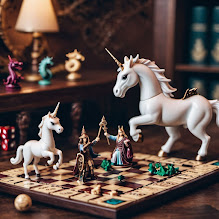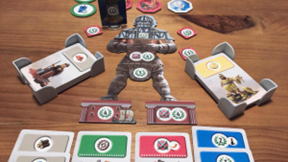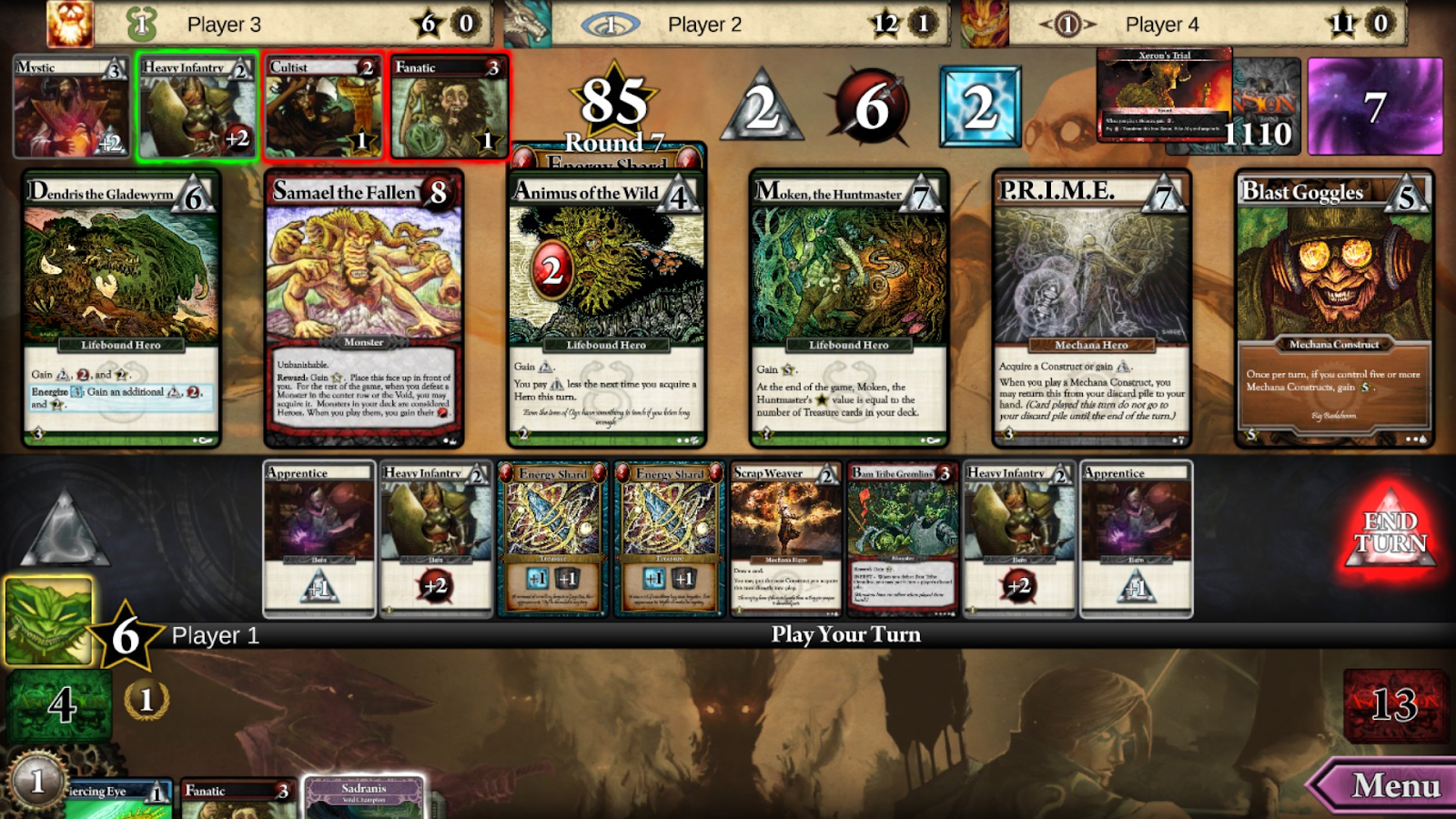Play is man’s earliest attempt at acquiring knowledge. As kids, we learn to playfully navigate our relationships with our surroundings and with others, through constant interactions that help us size up our limitations and our boundaries (in most instances defined by others). The outcome of these tests is then incorporated into our understanding of life. While our playful ways might have driven our adult caretakers crazy, we need to consider that early behaviour as the process leading us to a sort of emergent ruleset.
It is possible to draw parallels between early childhood play and board game design. In much the same way that we instinctively incorporate new rules of engagement into our early attempts at play, game designers use rulesets to determine the confines within which game interactions will take place. As in life, players need to subscribe to these rules to play a game correctly. Yet correct play is only relative to the rules we subscribe to. For example, in a fantasy setting it may be considered acceptable to attack and destroy an opponent to reach an objective. This obviously makes sense only within the confines of the gaming ruleset.
Yet for any of this to be relevant within the context of our day-to-day experiences, we need to ask what it adds to our experiences in life. For one, play allows us to explore hypothetical scenarios within the safety of what we can consider a mental sandbox. The sandbox encompasses all the elements of a particular situation and if we tackle the situation within that sandbox, no real harm can come to us. Yet, we will still reap the benefits from interacting with that sandbox, we will still learn something. The quality of learning then will only be as good as the ruleset we will be engaging with throughout our experience.
So, if it's all about rules, how do we go about establishing a sufficiently appealing ruleset to warrant repeat play? From my own experience, play is only as satisfying as its payoff, whatever that payoff might be. If we feel a sense of achievement when we complete a game, a sense that it was worth our time, then we will get back to playing it.
There are various ways to categorise games, but as I see it, there are essentially five game archetypes with all others being subsets of sorts or composites of two or more of the main types. These five types are: -
1. Games of Chance
2. Games of Logic and deduction
3. Games of Perfect Information
4. Games involving Strategy
5. Games involving Dexterity
Upon consideration, one can say that any game you can think about will incorporate one or more of the above. Chess for instance can be thought of as being a combination of 2,3 and 4. Backgammon can be thought of as being a combination of 1,2 and 4. The game Twister on the other hand can be considered a game which combines 1 and 5 mostly. Incorporating one or more elements from the list increases the likelihood that it will increase the level of engagement you can hope to achieve within a game. Some argue that incorporating more than one of the above elements would increase the sense of achievement derived from a game. This is not always the case, there are exceptions. Some very simple game designs have given rise to games that have withstood the test of time because of their simplicity rather than despite it.
Take for example the game “Shut the box”. This is a very elementary game that utilises just two dice and yet play is quick, exciting and scales up well as player counts increase. It utilises point 1 (games of chance) mostly with only a sliver of point 4 (games involving strategy) which rests mostly on a player’s grasp of statistics and variance. Have a look at the rules, history, and variants of this game by clicking on this Wikipedia® link (https://en.wikipedia.org/wiki/Shut_the_box)
Together these archetypes are capable of diverse synergies that make the resulting game both intriguing and intensely interesting. Yet, why does not everyone like chess or backgammon with the same intensity? Why do some people prefer some games over others? This is the conundrum that most of us will have to face and attempt to resolve if we wish to fully appreciate the scope and variety of the games that are available on the market today.
Indeed, the types of games played and their reliance on luck or skill (or a combination of both for that matter), rely on the proclivities and personal skillset of the players themselves. A potential player with a keen sense of logic and strategic thinking is more likely to grasp and appreciate the nuances of Chess or Go, then say, a person who may not be so gifted. There is also no direct line or thread between personal skillsets and the type of games played. Other factors may contribute to the choice or preference of game types.
It's not just the game types that make a difference when it comes to the popularity or universal appeal of the game, but also the cultural context in which that game was both created as well as played. For instance, if games of pure chance are frowned upon within a specific culture, games that incorporate such an element will not prove popular within that same culture. Likewise, within a warlike culture (think Viking culture that existed in northern Europe, 793-1066 CE), games which reward aggression or simulate war will most likely prove popular. For this reason, cultural context should not be overlooked when one is working on a particular ruleset.
Another aspect that needs to be addressed when creating rulesets is the tactile nature of games. I have noted in other blogs the importance of the tactile component of any board game. The pieces used to interact with a game are an important aspect. If a player enjoys engaging with the game pieces, he or she will most likely want to do so more often. I can still remember how fascinated I felt when I was first introduced to a chess set as a kid. A similar fascination struck me when I held a backgammon set for the first time in my life. I recall feeling particularly interested in the Knight as well as the Rook or Tower pieces. This interest then led me to sit down and try to learn the game. While I never really grew to love the game, I still have a fond memory of the first time I came across it. Contrarily, backgammon stuck with me ever since, it’s a fascinating game that espouses luck and strategy in ways few other games do.
When we think about whimsy, we are effectively thinking about something that engages the imagination, something playful or humorous. So, while the archetypes mentioned earlier can categorise games, they do not add to the whimsy as it were…not on their own. For a game to be whimsical in nature it needs to appeal to the child within, think the modern game “Root” (designed by Cole Wehrle and illustrated by Kyle Ferrin) where players control different factions of woodland animals vying for control over a forest…or the outright hilarious “Exploding Kittens” (designed by Elan Lee and Matthew Inman) where players try to avoid drawing an exploding kitten card.
Whimsy can be found in different elements within a game, from the theme itself to the gameplay and art employed. When it comes to gameplay think of the game Tsuro (designed by Tom McMurchie) where players place tiles to create a path for their dragon stone to follow, but if their stone runs off the board, they lose the game. When it comes to art, board games that embrace this sense of whimsy will often adopt bright and colourful artwork, think of the game Talisman 4th Edition (https://en.wikipedia.org/wiki/Talisman_(board_game)) and the fantastic illustrations on both the board itself as well as the cards used during play.
As for the archetypes mentioned earlier, people are attracted to whimsical games for any number of reasons. Some may find them a means to connect to their childhood. Through play, players relive those memories and, in some way, try to recapture some of the simple joy and wonder of those early years. Others may find these games inspiring. Whimsical games do, after all, encourage players to think outside the box and to come up with different strategies to win a game. They basically encourage thinking and experimenting with diverse ways to solve a specific challenge. Ultimately some may embrace whimsical games as a welcomed escape from the duress of everyday life. They can also prove to be a great way to connect with friends or family over a shared enjoyable experience at the gaming table.
Yet I feel that this exposition of what I have termed the whimsy in games cannot be complete without addressing another aspect, that of roleplaying games.
When I speak of roleplaying games, the first thing that will come to the minds of most readers will be Dungeons & Dragons and rightly so. This gaming system, developed by Gary Gygax has withstood the test of time and is currently experiencing an interesting renaissance. Yet this is a gaming system that does not require a gaming board or that many gaming pieces and still it is the embodiment of whimsy.
The fantastical worlds of the Forgotten Realms ™ envisaged by the D&D system, take players into vast sprawling landscapes where magic is real, encounters with dragons and mythical beasts a common occurrence and where the players themselves can choose to be any of a long list of Faerie folk both good and evil. The whole experience is guided and egged along by one player termed the Dungeon Master, who stands as the gatekeeper of the rules as well as the expert in lore. Everything happens in the mind, worlds are saved, treasure hordes looted, and dragons slain.
Yet even in this emperor of whimsical experiences, there are lessons to be learned and skills to be honed that extend far beyond the gaming table. Players here learn to work as a team, explore as a team, fight as a team and if needs be, die as a team. Yet everything is experienced within the safe confines of an imaginary world. A world with its own rules, cultures, customs, and beliefs.
Over time, Dungeons & Dragons players have encountered and explored a variety of real-world social issues through their gameplay. They have experimented with hypothetical scenarios that delve into topics such as racial intolerance, xenophobia, and cooperation between team members of different species. Additionally, they have tackled issues of identity, roles, and expectations. Despite being a game of imagination, “Dungeons & Dragons” has provided a platform for players to explore and learn about real-world issues.
While some may argue that roleplaying games still rely on painted miniatures, maps, and dice to some extent, only the dice are essential. The other two items are merely tools that can enhance the gaming experience. When a game designer creates a theme that captures the imagination of their target audience, the resulting game can become a unique manifestation of whimsy.
As I bring this discourse towards its end, I need to stress that what we have explored here is a deep aspiration towards personal and collective growth. As individuals, we strive to find the means to grow and attain a higher level of understanding, one that might not be possible to achieve through direct experience. On the other hand, through a guided foray into whimsical gameplay, we can aspire to go beyond and learn more about subjects we might not address daily. This learning process then is facilitated not only by the rulesets that comprise the sandboxed environment but also through interactions with other fellow students, and the players we meet at the table.
It is indeed up to us parents, tutors, and mentors to ensure that the next generation of gamers is encouraged to develop their sense of whimsy through play. To embrace the dialogue that results from interacting with these sandboxed environments. We can do this through several ways, and it doesn’t even have to be direct play, though that helps. The game designers and problem solvers of tomorrow need to be encouraged to express their creativity and to do so constructively. Even a minor, fledgling idea can be fanned into something outstanding given the right environment. This is what we seek to develop through the medium of play and whimsical games.
Until next time!














































